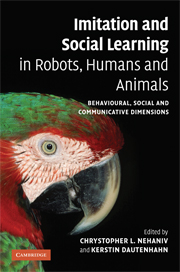 Imitation and Social Learning in Robots, Humans and Animals
Imitation and Social Learning in Robots, Humans and Animals Published online by Cambridge University Press: 10 December 2009
The Agent-based perspective
Imitation is a powerful learning mechanism and a general agent-based approach must be used in order to identify the most interesting and significant problems, rather than the prominent ad hoc approaches in imitation robotics research so far. The traditional approach concentrates in finding an appropriate mechanism for imitation and developing a robot control architecture that identifies salient features in the movements of an (often visually observed) model, and maps them appropriately (via a built-in and usually static method) to motor outputs of the imitator (Kuniyoshi et al., 1994, 1990). Model and imitator are usually not interacting with each other, neither do they share and perceive a common context. Effectively this kind of approach limits itself to answering the question of how to imitate for a particular robotic system and its particular imitation task. This has led to many diverse approaches to robot controllers for imitative learning that are difficult to generalize across different contexts and to different robot platforms. In contrast to the above, the agent-based approach for imitation considers the behaviour of an autonomous agent in relation to its environment, including other autonomous agents. The mechanisms underlying imitation are not divorced from the behaviour-in-context, including the social and non-social environments, motivations, relationships among the agents, the agents individual and learning history etc. (Dautenhahn and Nehaniv, 2002).
Such a perspective helps unfold the full potential of research on imitation and helps in identifying challenging and important research issues.
To save this book to your Kindle, first ensure [email protected] is added to your Approved Personal Document E-mail List under your Personal Document Settings on the Manage Your Content and Devices page of your Amazon account. Then enter the ‘name’ part of your Kindle email address below. Find out more about saving to your Kindle.
Note you can select to save to either the @free.kindle.com or @kindle.com variations. ‘@free.kindle.com’ emails are free but can only be saved to your device when it is connected to wi-fi. ‘@kindle.com’ emails can be delivered even when you are not connected to wi-fi, but note that service fees apply.
Find out more about the Kindle Personal Document Service.
To save content items to your account, please confirm that you agree to abide by our usage policies. If this is the first time you use this feature, you will be asked to authorise Cambridge Core to connect with your account. Find out more about saving content to Dropbox.
To save content items to your account, please confirm that you agree to abide by our usage policies. If this is the first time you use this feature, you will be asked to authorise Cambridge Core to connect with your account. Find out more about saving content to Google Drive.